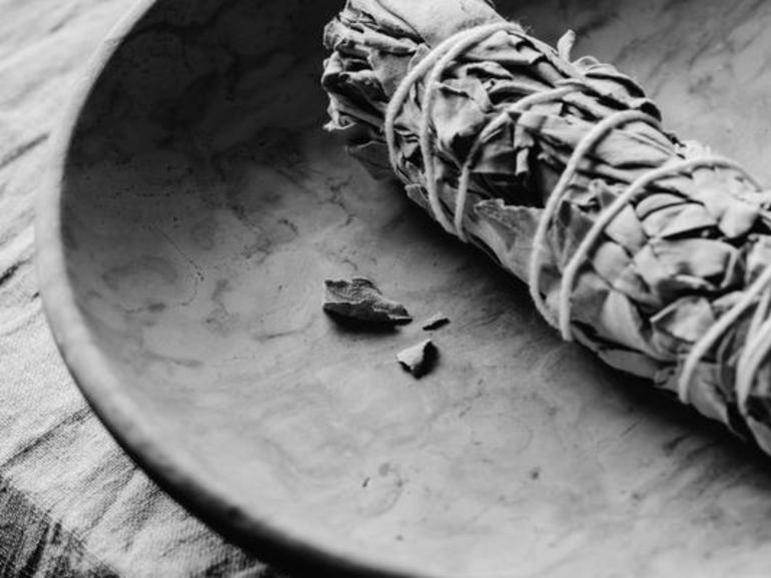Thomas Kevin O'Rourke
Image by Eva Elijas on Pexels
Thomas Kevin O’Rourke is a recovering street person, retired barge worker, and jack of all trades. He led men’s groups to end violence, deconstruct classism and racism, emphasize restorative justice and healing from atrocity and taught gestalt poetry in Minnesota prisons. He has been a Sundancer with the Sicangu of Rosebud Reservation for forty years.
Burial at Marty Mission
Shelia Red Horse survived for seventy years despite poverty, mission school, death of her adult son, alcoholism, diabetes, a mastectomy, and heart disease. Now, on Yankee Doodle Road in Eagan, Minnesota, a garage door opens. The funeral director rolls out a gurney with the corrugated cardboard box 12 inches high by 24 inches wide by 7 feet long.
I back my Ranger into the driveway. Val sits beside me, a bundle of silver sage on her lap. A certificate held fast to a Masonite clipboard gives me permission to carry Shelia from Minnesota over the South Dakota state line to the Yankton Reservation.
Leopard frogs bellow in the marsh along the Minnesota River. Everything is connected. I’m connected to the river and leopard frogs.
The funeral director and I work together, opening the tailgate and sliding the box into the pickup bed. A Ford Ranger is a small truck with a short bed. The head end of the box rests on the tailgate. I use orange ratcheting straps hooked to the bumper to secure Shelia from dumping onto the blacktop once we get on the road. With engine grease under my nails, I give the director the clipboard. The director signs the certificate and hands it back.
From the bundle of sage on her lap, Val pulls loose a stem, strips the leaves in one movement, rolls them in her palms to a ball, and places it in the blue shell from the Minnesota River. I tug the lighter from my jeans coin pocket that holds Shelia’s Native American Sobriety medallion. Light the sage. Blow out the flame so an ember burns. Thick smoke spirals, sharp and antiseptic. Someone might mistake the smell for pungent marijuana. With an eagle feather found by the river as a fan, I smudge Shelia’s box, Val, and drop pinches of tobacco on the blacktop.
Val talks to the box. “We’re taking you to Marty Mission, smart lady. I’m sure you’ll kick up a fuss as always. We got your back.”
An old family friend drives Shelia’s two grandchildren, an eight-year-old boy and a ten-year-old girl, to Yankton Reservation for the funeral. The big sister, seventeen-year-old Juno, and her gangbanger boyfriend, Marvin, ride along.
We’re all related. Val and I live across the street from Marvin. Drunk, Marvin busted the side window of my pickup and stole a gym bag stuffed with a dirty towel and socks. Sober, Marvin and cohorts spray-painted NGD, the acronym for Native Gangster Disciples, on my fence, which I painted over before the city fined me. And the guns. Either the rival Serrano or Native Mob drove by and unloaded 20 rounds from an Uzi at the house where Marvin stayed. When NGDs shot back, they hit our home and chipped the brickwork. I wonder if I can reach these guys through the summer arts programs. I lead tipi-building workshops at the Minneapolis American Indian Center and hope to put together a woodcutting crew for the sweat lodge.
As we drive south on I-35 to I-90, Val reads the certificate. “We better watch out,” she says. “The person responsible for transporting a body is to never let it out of his sight. Somebody
might steal it.”
I keep eyes on the road. “Tape a bow ribbon on the box. When somebody snatches Shelia at the truck stop, they’ll open the package and die of terror.”
“The curse of Shelia Red Horse,” Val says.
At the truck stop in Albert Lee just before the I-90 exit, we stop to piss and get gas. Before getting in the cab, I check the ratchet straps and take up the slack.
We get off I-90 to US 18, a hundred-mile stretch along the Missouri River. When we roll through the city of Yankton, Val points to a levee boat landing.
“Custer and the Seventh Calvary got off the steamboat here.”
Val worked as former interim director at the Native American College on Lake Street in Minneapolis. She knows the Dakota diaspora and the history of the nations that formed the army that hacked Custer to pieces at the Battle of the Greasy Grass.
She continues. “Shelia’s grandfather, Red Horse, painted a picture of the camps on Little Big Horn River.”
The illustration on a buffalo hide hangs in the Smithsonian, tipis marked with the nation’s symbols—Oglala, Miniconjou, Dakota, Sicangu, Arapaho, Cheyenne, Brule. Shelia’s grandfather, Red Horse, fought beside Sitting Bull, He Dog, Crazy Horse, American Horse, and Rain in the Face. They were Knights of the Round Table. A queen rests in a cardboard box in the back of my truck.
We drive past the city park. Val points at the Custer statue with sword and pistol on his hip, astride a horse. I’ll count coup on the way back with a string of black and white tobacco ties.
Beyond the town of Yankton, we find SD-50, a two-lane blacktop, and pull into a filling station and top off the gas with ethanol. The temperature in the nineties, the air reeks of pig shit. Inside the air-conditioned Denny’s restaurant, we take a booth seat at a window.
Val looks up from the menu and nods her chin toward the bed of the Ranger. Shelia’s box sits in full sun. Val says, “You think that funeral director pumped her full of formaldehyde?”
I raise eyebrows. “I sure hope so. I’m not sure. There was no money exchanged. Did Shelia’s tribe pay the director?”
Val puts on glasses to read the menu. “Let’s order before flies crawl inside the box.”
When we climb back into the Ranger, a dozen flies buzz around our faces. As I drive, Val opens the passenger side window to shoo them from the cab. The odor of pig shit wafts into the truck.
#
We pull up to the funeral home in Wagner by six that evening. There, relatives, negotiating for a real coffin, refuse the roller straps and hearse. They’ll carry the coffin in a flatbed of a firewood truck and use towropes when it comes time to lower Shelia into the ground.
The relatives lay Shelia’s body in the nice coffin at the indoor basketball court next to the tribal offices. Everyone keeps vigil for three more nights and days. The drum group sings Wakan Tanka Tunkasila. Sage burns nonstop in a river shell, the strong-smelling smoke keeping flies away. Plainclothes nuns arrive and sing as a choir. A white Baptist preacher sneaks in and stands beside her open coffin. Even though he never met her, he gestures to dead Shelia and preaches on the wages of sin. The nuns try to drown him out with their choir. Singers beat the drum harder and raise a high plains’ harmony.
Marvin stands over 6 feet, on the thick side, acne scars pitting both whiskerless cheeks. He wears gangbanger colors—Native Pride baseball cap over eyebrows and duckbill pointed sideways, oversized white T-shirt and black denim jeans, the top between mid-thigh and knee, blue boxer trunks and size 14 sneakers. He keeps a dozen children coloring at the foldout table.
Grandmothers roast chickens and boil potatoes in the kitchen. They reheat grease in the deep fryer for fry bread. Marvin mixes powdered lemonade with water in the cooler. An institutional coffeepot brews coffee. A bread basket filled with loose cigarettes sits next to foam cups.
Aunties and grandmothers shear their hair and lay it in the coffin beside Shelia. Val places a bundle of sage between Shelia’s folded hands. Gauzy cloth covers her face to keep away the flies. A star quilt drapes the lower half of the coffin. Her body smells of ripening in anticipation of the earth.
On the fourth day, relatives load Shelia and her coffin in the bed of the firewood truck and drive slow down the pocked blacktop to Marty Mission. Black Angus graze in the high plains on one side of the road. Children coasting on skateboards in the streets of the tribal housing on the other side.
We exit the vehicles and enter the Catholic cathedral in the middle of the prairie. Before the altar, a buckskinned statue of Holy Mother with a beatific smile, infant Christ cradled in her left arm, faces the congregation. I’m carrying a bundle of sage. An ancient white-haired nun touches my shoulder and points to an abalone shell and a hawk-wing fan on a small table by the altar. I roll sage into the shell, light it, then walk through the aisles to smudge everyone in the cathedral. I’ve done this a lot and do it with panache, fluttering the fan up and down the length of each person as they wave the smoke towards them, bathing in it, cleaning hearts and minds. This is for Shelia. This is her ceremony.
I go sit beside Val. She pulls at my sleeve and points upward. Stone pillars holding up an arched ceiling of indigenous designs and spirit animals, eagles, bears, bison, coyotes howling at the stars in the cobalt night.
A red-nosed priest improvises a homily from the lectern how Shelia drank her last glass of wine then lay down to eternal sleep. I yank Shelia’s Native American sobriety medal from my coin pocket, touch Val’s hand and mutter.
She tilts her head to hear me better. “What?”
“That wino priest is full of shit.”
Val squeezes my forearm. “I’ll take care of this.” She stands up and cuts the priest’s sermon short. Val’s voice echoes among the pillars. The congregation, Shelia’s nieces, nephews,
grandson by her first marriage, great-grandchildren and cousins, keep eyes on Val.
“Shelia Red Horse taught Native Studies at Metro State University, co-authored several books, helped set up the Heart of the Earth Survival School, and adopted her two grandchildren. In over 30 years, Shelia Red Horse had not a sip of alcohol, nor did she believe in a Christian God.
In the sacristy of this church, priests molested her when she was a girl. Nuns tortured her at the mission school around back. Shelia escaped and ran many times, always captured and returned until she no longer spoke or remembered the language of her parents and grandparents. She planned to be buried here to haunt the perpetrators and bear witness. And she died poor. Her two adopted children heard every horror of this place and now see it with their own eyes.”
Val looks around the congregation. The relatives, lips pursed, nod their heads. The priest, face blanched, says nothing else.
#
At Marty Mission Cemetery, across the blacktop from tribal housing laid out like a village, grandsons and nephews dig the grave in South Dakota earth beneath one of the only pines at the cemetery’s southeast corner. Most of the cemetery’s graves have small headstones with a name carved in them. A cast-iron Four-Direction wheel, like a minimal Celtic Cross, marks other graves. Melon-sized fieldstones mark a few.
Entrance to the underworld completed, shovels lean on the heap of yellow earth beside the grave. The grandsons and nephews who did the digging burn sage in the blue clamshell to smudge those who come to mourn. Horses from across the tallgrass prairie press against the fence. The nephews smudge them too. Nuns chatter among themselves in the shade of the pine. The priest finishes smoking a Marlboro, drops it to the dried grass and crushes the butt beneath his heel.
I’m studying the eight-year-old boy and ten-year-old girl, orphaned first by their murdered mother and now Grandma Shelia. They stand with Marvin and Juno, who cannot raise them. Val and I won’t abandon the children to the system. It will take a few weeks before all the paperwork is completed, navigating the Indian Child Welfare Act, and establishing huunka status of tribal ceremonial adoption. At Shelia’s request, we did the family-making ceremony in Shelia’s apartment six months before she died.
Juno behaves with adult dignity even though she’s been shacking with Marvin since she quit high school a year ago. Everything is connected. I worry because the war in my South Minneapolis neighborhood, where the Native Mob outguns the Native Gangster Disciples, spills into my yard. Native Mobsters put a bullet to the back of a boy’s head for trying to quit the gang. A goliath NGD picked up a young Native Mob wannabee by shoulder and hip and tossed him off the 18th Avenue Bridge onto the paved bike path. Val knows these boys from her neighborhood restorative justice program. I suspect Marvin, in his size 14s, threw the kid off the bridge. Marvin might live through the summer if he joins the drum group at the Minneapolis American Indian Center. Now we share community with each other away from the streets.
A young man asks Marvin to grab the end of a towrope and help lower Shelia into the grave. The priest recites the Lord’s Prayer, and everyone recites with him. The nineteen-year-old nephew who sang in a tenor at the drum in the gym now sings a Dakota song that honors grandmothers. Each mourner places a shovelful of earth and a handful of tobacco on the casket. Shelia’s grave has no carved headstone, no Four Direction wheel. Everyone has a job gathering fieldstones from under the yellow pine.
A relative offers me a cigarette. They know I Sundance with the Siĉhaŋǧu on Rosebud Reservation.
Everything is connected like the threads of a spider’s web, threads that become cables mooring us together.
I recall a schoolboy with a stolen cigarette. I lit the fuse of a Black Cat firecracker shoved in a leopard frog’s throat. The next frog utters a small cry. The boy awakens too late to snuff the fuse, guts across my nose and chin.
The relatives ask me to sing the Wiping of the Tears and another song for someone standing alone on the hill and facing infinity.
©2022 West Trade Review
__________________________________________________________________________________________________________________________________________________________________________
__________________________________________________________________________________________________________________________________________________________________________
__________________________________________________________________________________________________________________________________________________________________________
__________________________________________________________________________________________________________________________________________________________________________
__________________________________________________________________________________________________________________________________________________________________________
Stay Connected to Our Literary Community. Subscribe to Our Newsletter
Listen to Essay Here:
NONFICTION



